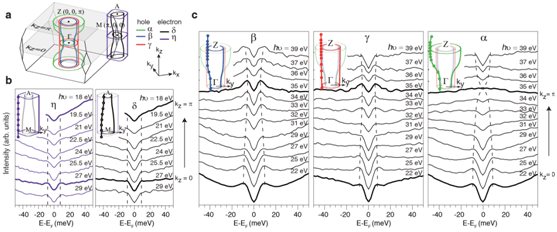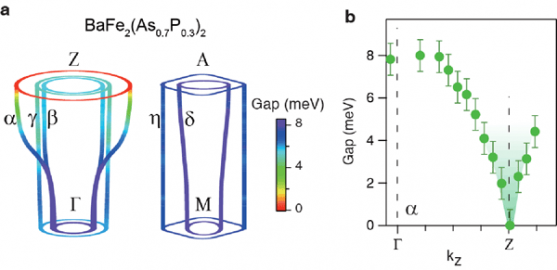The pairing symmetry of Cooper pair is a pivotal characteristic for a superconductor. In particular, the existence of nodes (that is zero gaps) or line nodes of the superconducting gap often imply unconventional pairing mechanisms. For example, the cuprates and conventional phonon-mediated superconductors are characterized by distinct d-wave and s-wave pairing symmetries with nodal and nodeless gap distributions, respectively. However, the superconducting gap distributions in iron-based superconductors are rather diversified. Whereas nodeless gap distributions have been directly observed in Ba1−xKxFe2As2, BaFe2−xCoxAs2, KxFe2−ySe2, and FeTe1−xSex (1, 2), the signatures of nodal superconducting gaps have been reported in LaOFeP, LiFeP, KFe2As2, BaFe2(As1−xPx)2, BaFe2−xRuxAs2 and FeSe (3, 4). So far, the key to resolve this divergence, namely the momentum location of the nodal gap, remains unknown.
Utilizing the high-resolution angle-resolved photoemission spectroscopy (ARPES) apparatus at beamline 5-4 of SSRL, scientists from the Department of Physics at Fudan University have successfully determined the nodal gap structure of an iron-based superconductor for the first time. They have measured the detailed superconducting gap structure of a ferropnictide superconductor BaFe2(As0.7P0.3)2, and in particular directly observed a circular line node on the largest hole Fermi surface sheet around the Z point at the Brillouin zone boundary.

The Fermi surface of BaFe2(As0.7P0.3)2 is shown in Fig. 1a. There are three hole Fermi surface sheets (FSs) (a, b and g) surrounding the central G–Z axis of the Brillouin zone, and two electron FSs (d and h) around the zone corner. By changing the photon energy and acceptance angle, one could investigate the momentum distribution of the superconducting gap on all FSs in the three-dimensional Brillouin zone. Detailed survey on the electron FSs revealed a nodeless superconducting gap with little kz dependence (Fig. 1b). However, for the a hole FSs, the experimental data clearly shows a zero superconducting gap or nodes located around the Z point (Fig. 1b).
The gap distribution of BaFe2(As0.7P0.3)2 is summarized in Fig. 2. Such a horizontal line-node distribution immediately rules out the d-wave pairing symmetry, which would give four vertical line nodes in the diagonal directions (q = ± 45◦, ± 135◦), as in the cuprates. The horizontal ring node around Z in BaFe2(As0.7P0.3)2 is not forced by symmetry, as it is fully symmetric with respect to the point group. Therefore, it is an “accidental” one, which is probably induced by the strong three-dimensional nature of the a band, for example, its sizable d3z2−r2 orbital character near Z (5, 6). These findings rule out a d-wave pairing origin for the nodal gap, and establish the existence of nodes in iron-based superconductors under the s-wave pairing symmetry.

- Y. Zhang, et al., Nature Mater. 10, 273–277 (2011).
- P. Richard, et al., Rep. Prog. Phys. 74, 124512 (2011).
- K. Hashimoto, et al., Phys. Rev. B 81, 220501 (2010).
- J. Hirschfeld, et al., Rep. Prog. Phys. 74, 124508 (2011).
- K. Suzuki, et al., J. Phys. Soc. Jpn 80, 013710 (2011).
- Y. Su et al., arXiv, 1110.0695 (2011).
Y. Zhang, Z. R. Ye, Q. Q. Ge, F. Chen, Juan Jiang, M. Xu, B. P. Xie and D. L. Feng*, Nodal superconducting-gap structure in ferropnictide superconductor BaFe2(As0.7P0.3)2, Nature Physics, doi:10.1038/nphys2248 (2012).




